
Exhibition Opening: September 8, 2017, 6pm
“Living in America,” a phrase written on wooden panels traveling with the model of Frank Lloyd Wright’s Broadacre City (1929–58), evokes a question that preoccupied architects and planners throughout the mid-twentieth century: How to live together? Wright’s proposal for an exurban settlement of single-family houses offered one possible answer; plans for large public or subsidized housing located in urban areas presented another. Although these two visions seem a world apart, they share a common history.
Wright (1867–1959) first exhibited his Broadacre City project at Rockefeller Center in Midtown Manhattan in 1935. While the prominent Wisconsin-based architect anticipated a degree of economic diversity, Broadacre’s residents were, for the most part, implicitly white. In 1936 construction began on one of New York City’s first public housing developments, the Harlem River Houses, funded by the Public Works Administration under President Franklin D. Roosevelt’s New Deal. Built for working-class African Americans, the complex was designed by a consortium including John Louis Wilson Jr., the first African American to graduate from Columbia University’s School of Architecture. Through such parallel examples, this exhibition showed how two different approaches to housing combine societal aspiration with racial segregation and socioeconomic inequality, and asked: How to live in America, together?
The exhibition’s narrative took the form of two interwoven plotlines, developed through displays of project-specific drawings, photographs, and other material dating from the late 1920s to the late 1950s. One plotline tracked the Broadacre scheme as it plays out in Wright’s subsequent work, scattered around the country; the other tracked the development of public housing in Upper Manhattan’s Harlem neighborhood, ending just outside the gallery, adjacent to Columbia’s new campus. Both stories connected social institutions, such as the nuclear family, with economic structures, such as private property or its alternatives. Wright’s version of the “American Dream” and Harlem’s public housing both draw lines of race, class, and gender, many of which persist today. Their differences remind us that the right to housing once defined, and could still define, what it means to live in America.
Living in America was curated by the Temple Hoyne Buell Center for the Study of American Architecture at Columbia University’s Graduate School of Architecture, Planning, and Preservation (GSAPP), and was co-presented by the Buell Center, the Miriam and Ira D. Wallach Art Gallery, and Avery Architectural and Fine Arts Library. The exhibition was presented in correlation with Frank Lloyd Wright at 150: Unpacking the Archive, which was on view at the Museum of Modern Art, New York, from June 12 through October 1, 2017. “Broad Acres and Narrow Lots,” an associated essay by David Smiley, Assistant Director of the Urban Design Program at Columbia GSAPP, was included in the MoMA exhibition catalogue. Living in America’s curatorial team was composed of students from various Columbia University masters and doctoral programs together with the Center's staff and in close collaboration with archivists from the Avery Architectural and Fine Arts library and other institutions.
The Buell Center research team included: Erik Carver (Harlem Team Leader), Daniel Cooper, Clara Dykstra, Robin Hartanto Honggare, Neha Krishnan, Tola Oniyangi, Julie Pedtke, Jiexi Qi, Alexander Hilton Wood (Frank Lloyd Wright Team Leader), Ashley Wu, and Zhengyang (Echo) Yue. Nick Bloom, Matt Lasner, Nancy Later, Richard Plunz, Abbe Schriber, David Smiley, and Joseph Watson were also consulted.
The exhibition design team included: Project Projects: Shannon Harvey, Prem Krishnamurthy, Lauren Bishop, Janet Chan, Chris Wu; and Leong Leong: Dominic Leong, Gabriel Burkett.
Archival material was drawn from: Avery Architectural & Fine Arts Library, Columbia University; Columbia University Archives; Cornell University Library, Rare and Manuscript Collections; Dwight D. Eisenhower Presidential Library; Frank Lloyd Wright Foundation Archive (The Museum of Modern Art | Avery Architectural & Fine Arts Library, Columbia University, New York); Hagley Museum and Library; The LaGuardia and Wagner Archives, Fiorello H. LaGuardia Community College/CUNY; The Library of Congress; The Museum of the City of New York; The National Archives; New York City Municipal Archives; The New York City Housing Authority; Rockefeller Archive Center; Schomburg Center for Research in Black Culture; Syracuse University Library, Special Collections Research Center; University of Massachusetts at Amherst, DuBois Archive; Wayne State University, Walter P. Reuther Library; The Wisconsin Historical Society.
Exhibition press coverage included: Architect Magazine, The Architect's Newspaper, Architectural Digest, CityLab, Columbia Spectator, Common Edge, Metropolis Magazine, The New York Times, and VICE Motherboard.
Header image designed by Project Projects, featuring:
Mattie Carrie Faulkner and her two children moving in, July 29, 1947, photoprint; Photographs & Prints Division, Schomburg Center for Research in Black Culture, New York Public Library
View of Benjamin Adelman House, 1951, photoprint; The Frank Lloyd Wright Foundation Archives (The Museum of Modern Art | Avery Architectural & Fine Arts Library, Columbia University, New York)
For other images (along with their credits), please visit the Living in America exhibition page on Columbia GSAPP's website. A PDF of the exhibition's caption cards is available here.
More exhibition-related information, including public programming, is available here.
Images © Naho Kubota.







